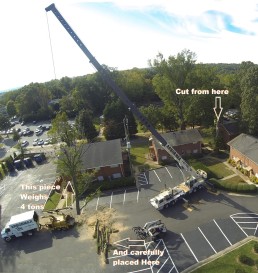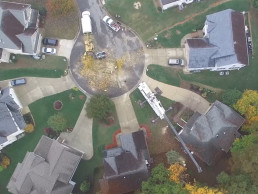We use our cranes to provide NO IMPACT tree removals.
 Tree removal with the assistance of a crane is almost always the safest way to do it. Not only is it the safest, it is the quickest and usually the most cost effective method. Traditional tree removal methods are often a lengthy process and can be significantly more labor intensive than a crane assisted tree removal. They require complex rigging of tree parts to control small sections of tree around valuable property, and usually have inferior results compared to the crane assisted tree removal process. When a crane is incorporated in tree removal, it significantly reduces the amount of time that it takes to remove a tree compared to the traditional fashion. It reduces the need for foot and equipment traffic on the lawn and throughout the property and as a result it decreases the impact and foot print left behind when the work is complete. The use of a crane allows us to provide a safe and efficient, no impact tree removal at a lower cost than tedious, and time consuming traditional methods.
Tree removal with the assistance of a crane is almost always the safest way to do it. Not only is it the safest, it is the quickest and usually the most cost effective method. Traditional tree removal methods are often a lengthy process and can be significantly more labor intensive than a crane assisted tree removal. They require complex rigging of tree parts to control small sections of tree around valuable property, and usually have inferior results compared to the crane assisted tree removal process. When a crane is incorporated in tree removal, it significantly reduces the amount of time that it takes to remove a tree compared to the traditional fashion. It reduces the need for foot and equipment traffic on the lawn and throughout the property and as a result it decreases the impact and foot print left behind when the work is complete. The use of a crane allows us to provide a safe and efficient, no impact tree removal at a lower cost than tedious, and time consuming traditional methods.
Other than the chainsaw, cranes are the next best addition to our industry. For decades, cranes have been utilized by tree services, but over the past 20 years, they have become far more popular. It is becoming very common for tree services to rent cranes. You never know what you are going to get when you use a rental company. Here at Arbormax tree service we are proud to own and operate our cranes.
Every one of our Crane operators are CCO certified. They have been through an extensive training program. The CCO certification is one of the hardest certifications to attain. I takes years of experience and knowledge to even be considered for the test. That’s not enough to operate a crane in tree work procedures. It takes skill that surpasses the average crane operator. Removing trees with a crane, like arboriculture, is an art and a science. Every tree responds differently to the effects of gravity, and must be handled differently.

Cranes are the best way to remove unwanted trees.
Other than the chainsaw, cranes are the next best addition to our industry. For decades, cranes have been utilized by tree services, but over the past 20 years, they have become far more popular. It is becoming very common for tree services to rent cranes. You never know what you are going to get when you use a rental company. Here at Arbormax tree service we are proud to own and operate our cranes.
Every one of our Crane operators are CCO certified. They have been through an extensive training program. The CCO certification is one of the hardest certifications to attain. I takes years of experience and knowledge to even be considered for the test. That’s not enough to operate a crane in tree work procedures. It takes skill that surpasses the average crane operator. Removing trees with a crane, like arboriculture, is an art and a science. Every tree responds differently to the effects of gravity, and must be handled differently.
100% Satisfaction Guarantee
Give us a chance and you will see what makes us the best
THE PROCESS

Step 1 – Formulate a work plan
Upon arrival, the tree removal team will evaluate the jobsite and conduct a pre work meeting. During their meeting they will discuss numerous things. Such as the ideal spot for the crane to be set up, the best spot for the other trucks and equipment to be staged and what obstacles and limiting factors are present. There are numerous elements that must be considered. Grade/elevation changes, utility lines and other overhead obstacles as well as the distance from the tree to the crane and from the crane to the landing zone.
Step 2 – Set up the crane
Once the best place to position the crane has been determined, we safely pull into the work zone and begin to level the crane. Plywood and wood blocks will be used for cribbing and footing under the outriggers. This will provide stabilization and additional height to level the crane. The crane must be perfectly level to ensure 100% stability during tree removal operation. The crane is designed with 5 outriggers/stabilizers that lift the crane off of the ground and support it during operation. The set up procedure typically takes about thirty minutes, which is longer than the time needed to remove an entire tree with the crane.


Step 3 – Formulating an approach to the tree removal
Every tree is unique and demands a different approach and plan for tree removal. The tree climber and crane operator will develop a plan for the tree removal process before lifting the tree climber into the tree. Every cut will be planned and discussed thoroughly. The tree removal will then begin once plan has been made and is fully understood. There are many things that must be taken in to consideration. Such as the weight of each piece that is going to be removed, the attachment point of the crane cable, the balance point of the section and the available space that the pieces will be maneuvered through and lowered into. The crane operator and tree climber must possess the ability to determine the weight of piece before it is cut. The crane may turn over if the piece is too heavy and exceeds the safe operating capacity of the crane. Tree structure and growth pattern are determining factors too. Oak trees with large limbs that grow horizontally will require a different approach than a Pine tree that has a vertical growth pattern.
Step 4 – The cutting process
Now we can remove the tree. Let the fun begin. The climber secures his lifeline to a secure point above the ball of the crane. He will then use a variety of hand signals for the crane operator to lift him to the designated point where the climber will attach the crane to the tree for removal. Once the climber has securely attached the cranes cable to the tree, tension will be applied. The Climber then rappels down the tree to a designated point where the cut will be made, and reconnect his lifeline to the tree. After the climber has safely secured himself to the tree, he will make the necessary cut. As the cut is being made, the crane operator applies the necessary amount of pressure, and adjusts the boom as needed to ensure as the cut is finished, the section of tree can be safely maneuvered away from the climber and carried to the landing zone.


Step 5 – Disposal of the cut pieces
Once the cut section of the tree is in the landing area, our ground operations specialist will go to work on it. First they will unhook the crane cable and signal for the operator to return it to the tree climber for the next cut. Then they will disassemble the tree like a group of termites on steroids with chainsaws. Pieces that are bigger than nine inches in diameter will have all of the limbs cut off and the log itself will be measured and cut into precise lengths. They will be taken to mill and sold. If the piece is smaller than nine inches it will be processed by the wood chipper and turned into wood chips.
